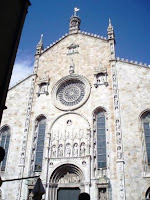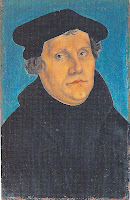VILLAS, GARDENS AND MILANO
We wandered down to the centre of Como, visited the Cathedral which is not an overwhelming site and not easy to photograph as the square was filled with restaurants virtually crowding out the entry.
I was happy to sit down and just think about Bruegel. What had I learnt? Looking at my scatty notes later in the evening, I knew how confused I was. Tomorrow would be a nice day on the Lake and I hoped not too much rush. We were to go to Tremezo - a two hour trip from Como and then onto Bellagio a short hop away. There are many villas to visit along the lake and it would be easier perhaps to take more time than we did. First stop was the Villa Carlotta at Tremeza.
I am not going to even try to give the history of this villa except perhaps to say that it was given to Carlotta by the heirs who sold the villa in 1843 to Princess Marianne of Nassau, Albert's of Prussia wife, who then gave it as a present to her daughter Carlotta on occasion of her wedding with George II of Saxen-Meiningen. This is history which I have no relation too and would need years to try and fathom out all the families.
Bellagio is another beautiful township of the lake. Flowers everywhere and to be visited at length. We had time to do a short trot around the Gardens of Villa Melzi which stretch along the lakeside. Time to relax but not time enough to really enjoy the beauty of the surroundings.
We were on our way to Milan that night and only the morning to visit. It was of course the DUOMO which was overwhelming for me. Marielle read a lot of the history to me but I find this difficult to take in when I can’t relate to historical periods.
After the Como Duomo it was overpowering but I am only too happy to sit and take in as much as I can. The Cathedral was started in 1386 and took over 5 centuries to build. Medieval, Gothic....Supposedly the third biggest in the world after Saint Pierre in Rome and the cathedral in Seville but Marielle told me, and this I will remember that Félix Houphouët-Boigny a rather corrupt African minister and first President of the Ivory Coast had a Basilica built for the small sum of 300 million $. The Guinness World Records lists it as the largest church in the world, having surpassed the previous record holder, St. Peter's Basilica, upon completion in 1989. The statue I found fascinating was Saint Bartholmy - skinned. Macarbe of course.
The highlight of the Milanese visit for me was the Poldi Pezzoli Museum.
The museum was originated in the 19th century as private collection of Gian Giacomo Poldi Pezzoli and his mother, Rosa Trivulzio, and has a particularly broad collection of Northern Italian and (for Italy) Netherlandish/Flemish artists.
I have become fascinated by portraits of the 14th, 15th and 16th century. For many centuries, portrait paintings were always profile and then somewhere at the end of the 15th portraits became full face. What intrigues me is that so many religious paintings from very early on, we see the face of Jesus, the Virgin, and many other religious people not to mention mythological characters. Why then a portrait profile for so many centuries before painting a full face?
There was the most fabulous collection of watches and clocks and sun dials compass which were very rare indeed. No photographs to be found. Such a shame. There was a tiny one in the shape of a ship, in ivory and even on the mast - right on top - you could see a tiny sailor. This dated from François 1er, 15th 16th century. It was as we say, «a petit bijou» and one of four sundials which exist from this period. Two are in the Museum.
Each room was richly carved. The collection fantastic. I think we both enjoyed ourselves immensely - in different ways.
 |
| Part of th front of cathedral |
I am not going to even try to give the history of this villa except perhaps to say that it was given to Carlotta by the heirs who sold the villa in 1843 to Princess Marianne of Nassau, Albert's of Prussia wife, who then gave it as a present to her daughter Carlotta on occasion of her wedding with George II of Saxen-Meiningen. This is history which I have no relation too and would need years to try and fathom out all the families.
 |
| Looking up from the entrance at the Villa Carolotta |
 |
| Apparently not too hot for fun and games |
 |
| Looking down from the top steps |
 |
| Divine gardens |
 |
| And beautiful flowers |
Bellagio is another beautiful township of the lake. Flowers everywhere and to be visited at length. We had time to do a short trot around the Gardens of Villa Melzi which stretch along the lakeside. Time to relax but not time enough to really enjoy the beauty of the surroundings.
 |
| Trees and every thinkable green |
 |
| a small creature in front of a huge tree |
 |
| Yellow leaves shining in the sun |
We were on our way to Milan that night and only the morning to visit. It was of course the DUOMO which was overwhelming for me. Marielle read a lot of the history to me but I find this difficult to take in when I can’t relate to historical periods.
 |
| Il Duomo |
 |
| St Bartholomy |
The highlight of the Milanese visit for me was the Poldi Pezzoli Museum.
The museum was originated in the 19th century as private collection of Gian Giacomo Poldi Pezzoli and his mother, Rosa Trivulzio, and has a particularly broad collection of Northern Italian and (for Italy) Netherlandish/Flemish artists.
I have become fascinated by portraits of the 14th, 15th and 16th century. For many centuries, portrait paintings were always profile and then somewhere at the end of the 15th portraits became full face. What intrigues me is that so many religious paintings from very early on, we see the face of Jesus, the Virgin, and many other religious people not to mention mythological characters. Why then a portrait profile for so many centuries before painting a full face?
 |
| Vincenzo Foppa - Giovanni Francesco Brivio 1495? One of the best portrait paintings of that period |
 |
| Cranach 1553 |
 |
| Cranach 1553 |
 |
| Boltraffio 1495 |
 |
| Truimphal Carriage Clock - South Germany 1610 |
 |
| A medieval sculpture in wood |
 |
| A vessel I liked |
There was the most fabulous collection of watches and clocks and sun dials compass which were very rare indeed. No photographs to be found. Such a shame. There was a tiny one in the shape of a ship, in ivory and even on the mast - right on top - you could see a tiny sailor. This dated from François 1er, 15th 16th century. It was as we say, «a petit bijou» and one of four sundials which exist from this period. Two are in the Museum.
Each room was richly carved. The collection fantastic. I think we both enjoyed ourselves immensely - in different ways.




Commentaires